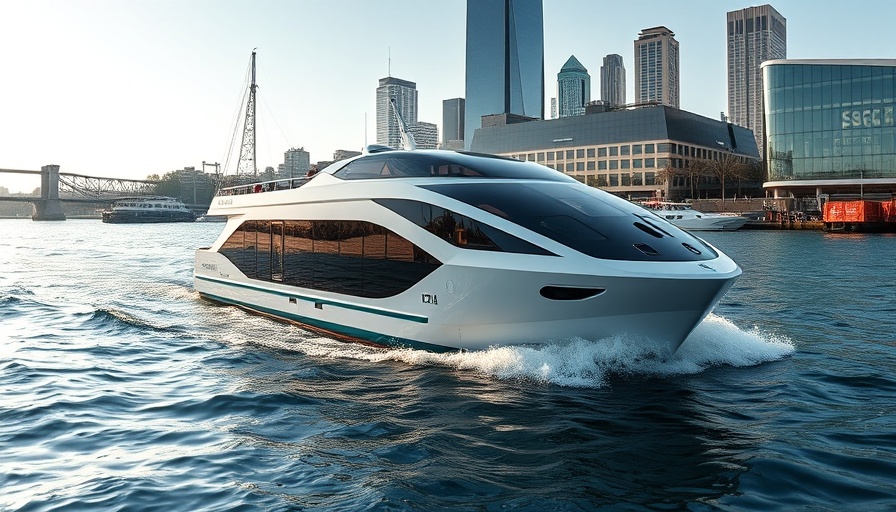
Sydney's Water Transport Revolution: The Candela P-12 Electric Ferry
Imagine gliding smoothly across Sydney Harbour at 25 knots without the rumble of diesel engines or the jostling of turbulent waters. Thanks to innovative technology from Swedish company Candela, this dream is becoming a reality with the introduction of the Candela P-12, the world's first hydrofoil electric ferry. This groundbreaking vessel not only promises to modernize Sydney's iconic public transport system, but it may also lead the way in sustainable water transportation.
What is the Candela P-12?
The Candela P-12 is the first of its kind, utilizing hydrofoils—computer-guided wings that lift the vessel above the water's surface, significantly reducing water resistance. This allows the ferry to cruise at impressive speeds while consuming 80% less energy than conventional ferries. With a range of 40 nautical miles on a single charge, the P-12 is perfectly designed for the routes that crisscross Sydney Harbour.
Why This Matters: Environmental Impact and Cost Efficiency
Sydney's ferry system has faced criticism for lagging behind global green initiatives as traditional diesel vessels emit greenhouse gases that contribute to climate change. The Candela P-12 offers a solution by drastically cutting emissions and operational costs—providing a compelling business case for public operators. With every journey on the P-12, Sydney can reduce its carbon footprint, moving towards a more sustainable future. According to Candela’s CEO, Gustav Hasselskog, “With this transition, not only do we save the environment, but we also save money.”
A Smooth, Fast Ride: Passengers Will Rejoice
Passengers aboard the P-12 will experience a ride like no other—no rough seas or jarring motions, thanks to its innovative digital flight controller that maintains balance by adjusting the foils in real-time. This results in a serene journey, ideal for commuters looking to start their day stress-free or tourists eager to take in Sydney’s breathtaking sights.
Historical Context: The Evolution of Sydney's Ferry System
For well over a century, ferries have been an integral part of Sydney's identity. Yet, as the city’s population grows and environmental concerns escalate, the need for modernization has never been more urgent. The Candela P-12 stands out against the backdrop of a fleet relying on aging, environmentally harmful technologies.
Innovation Across the Globe: Lessons from Other Countries
The success of electric hydrofoil ferries isn't merely theoretical; other nations have already begun to reap the rewards. Noteworthy successes in Stockholm, where the P-12 operates effectively, show a reduction in travel times by up to 50% compared to traditional services. The ferry's introduction has created high demand and satisfaction among riders, reflecting a reliable shift towards future sustainable transportation.
Future Predictions: The Expanding Role of Electric Ferries
The introduction of Candela's P-12 in Sydney could be a catalyst for a broader transition to electric vessels globally. Experts predict that cities around the world will follow suit, reimagining public transport on waterways. “Once we demonstrate the benefits here in Sydney, it could inspire a seismic shift in maritime transport,” Hasselskog notes.
Public Reception and Excitement: Sydney Awaits
As Sydney prepares for the deployment of the P-12, public anticipation continues to grow. Will it truly fulfill the promise of faster, cleaner, and more affordable transport on the water? Initial trials and demonstrations are set to showcase this avant-garde vessel during the Sydney Harbour Concours d'Élégance and the Everything Electric Show, promising an eye-opening experience for attendees.
With its capacity for 31 passengers, including space for bicycles and accessibility provisions, the P-12 isn’t just about speed—it’s about creating an inclusive transport system that caters to everyone.
Your Turn: Embrace the Future of Water Transport
The Candela P-12 represents more than just an electric ferry; it embodies a sustainable shift in transportation and invites us all to consider what a future powered by clean technology might look like. As Sydney's waterfront gears up for this transformation, it’s imperative for locals and policymakers alike to embrace these advances, ensuring that environmental concerns don't compromise efficiency and comfort.
As you contemplate the transition of Sydney's ferries into the electric age, think about how technology can enhance our daily lives while respecting the planet. We must be proactive in calling for innovative solutions that protect our environment while also improving urban commutes for everyone. Are you ready to take the plunge into a greener, more efficient transport future?
 Add Row
Add Row  Add
Add 




Write A Comment